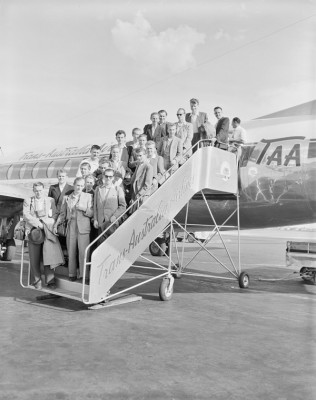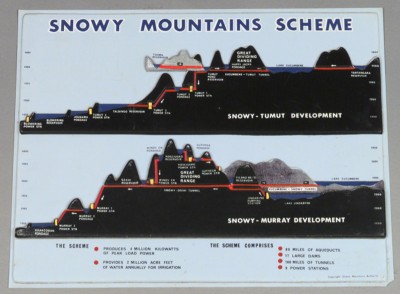The building of the Snowy Mountains Hydro-Electric Scheme was a pivotal event in Australia’s history. Not only did it create one of the engineering wonders of the modern world, it also laid the foundations of a uniquely multicultural modern nation.
After World War II, Europe was in chaos, Germany was crushed and the map of Europe was being carved up by the United States and the Soviet Union. Western Europe was supported by the United States while Eastern Europe was invaded by the Soviet Union. Refugees began streaming out of Eastern Europe to places like Australia and the United States to get away from the oppression in their homelands. The Cold War between the United States and the Soviet Union meant that nuclear war was a real threat and some people saw Australia as a safe place to live.
Between 1945 and 1965 more than two million migrants came to Australia. ‘Populate or perish’ became the catchcry, as the Australian Government embarked on an intensive international promotional campaign to encourage migration to Australia. Most were assisted where the government paid most of their fare to get to Australia. The campaign initially targeted Britons with schemes such as ‘Bring out a Briton’, but later it was expanded to provide assistance and reunion schemes to other Europeans.

German migrants arrive onboard a T.A.A. Viscount flight. C.1956
These migrants flew from Hamburg, Germany, under the assisted passage scheme sponsored by the Inter-governmental Committee for European Migration. Courtesy National Archives of Australia.
The first major post – war wave of migration started with displaced persons. These people fled their countries because their homelands were destroyed in the war or they had been taken over by the Soviet Union. Between 1947 and 1953, the Australian Government assisted over 170,000 displaced persons to migrate to Australia. Many came from Eastern Europe where they had suffered terribly during the war. In return they had to stay in Australia for at least two years and work in whatever jobs the government gave them.
A number of migrants spent their first months in Australia living in migrant hostels while they tried to find themselves a home. Some found work in factories; others did the hard and dirty jobs in heavy industry. Skilled migrants found it hard to have their training and qualifications recognised and had to accept what work was available. All migrants, especially those who did not speak English well, had to put up with prejudice.
The second wave of post-war immigration arrived in the 1950s and 1960s, and consisted of those seeking employment and better living conditions. These included migrants from Italy, Greece, Malta, Croatia and Turkey. These programs were an enormous success. The origins of ‘New Australians’ changed markedly, with British migrants only making up half of the intake, and many migrants coming from southern, eastern and northern Europe. This meant the end of Anglo hegemony in Australia. In 1955 the one millionth migrant arrived in Australia and mass migration programs continued into the 1970s.



